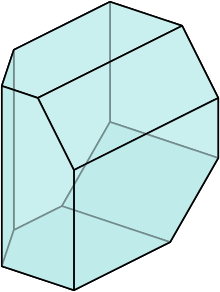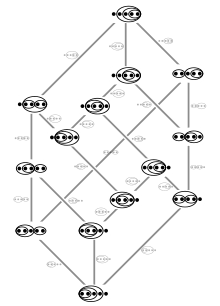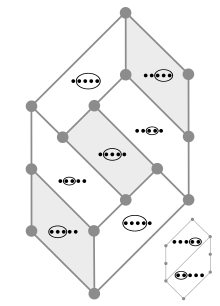Associahedron



Each vertex in the above Hasse diagram has the ovals from the 3 adjacent faces. Faces whose ovals intersect do not touch.
In mathematics, an associahedron Kn is an (n − 2)-dimensional convex polytope in which each vertex corresponds to a way of correctly inserting opening and closing parentheses in a word of n letters and the edges correspond to single application of the associativity rule. Equivalently, the vertices of an associahedron correspond to the triangulations of a regular polygon with n + 1 sides and the edges correspond to edge flips in which a single diagonal is removed from a triangulation and replaced by a different diagonal. Associahedra are also called Stasheff polytopes after the work of Jim Stasheff, who rediscovered them in the early 1960s[1] after earlier work on them by Dov Tamari.[2]
Examples
The one-dimensional associahedron K3 represents the two parenthesizations ((xy)z) and (x(yz)) of three symbols, or the two triangulations of a square.
The two-dimensional associahedron represents the five parenthesizations of four symbols, or the five triangulations of a regular pentagon. It is itself a pentagon.
The three-dimensional associahedron K5 is an enneahedron with nine faces and fourteen vertices, and its dual is the triaugmented triangular prism.
Realization
Initially Jim Stasheff considered these objects as curvilinear polytopes. Subsequently, they were given coordinates as convex polytopes in several different ways; see the introduction of Ceballos, Santos & Ziegler (2015) for a survey.[3]
One method of realizing the associahedron is as the secondary polytope of a regular polygon.[3] In this construction, each triangulation of a regular polygon with n + 1 sides corresponds to a point in (n + 1)-dimensional Euclidean space, whose ith coordinate is the total area of the triangles incident to the ith vertex of the polygon. For instance, the two triangulations of the unit square give rise in this way to two four-dimensional points with coordinates (1, 1/2, 1, 1/2) and (1/2, 1, 1/2, 1). The convex hull of these two points is the realization of the associahedron K3. Although it lives in a 4-dimensional space, it forms a line segment (a 1-dimensional polytope) within that space. Similarly, the associahedron K4 can be realized in this way as a regular pentagon in five-dimensional Euclidean space, whose vertex coordinates are the cyclic permutations of the vector (1, 2 + φ, 1, 1 + φ, 1 + φ) where φ denotes the golden ratio. Because the possible triangles within a regular hexagon have areas that are integer multiples of each other, this construction can be used to give integer coordinates (in six dimensions) to the three-dimensional associahedron K5; however (as the example of K4 already shows) this construction in general leads to irrational numbers as coordinates.
Another realization, due to Jean-Louis Loday, is based on the correspondence of the vertices of the associahedron with n-leaf rooted binary trees, and directly produces integer coordinates in (n − 2)-dimensional space. The ith coordinate of Loday's realization is aibi, where ai is the number of leaf descendants of the left child of the ith internal node of the tree (in left-to-right order) and bi is the number of leaf descendants of the right child.[4]
It is possible to realize the associahedron directly in (n − 2)-dimensional space as a polytope for which all of the face normal vectors have coordinates that are 0, +1, or −1. There are exponentially many combinatorially distinct ways of doing this.[3][5]
Because K5 is a polyhedron only with vertices in which 3 edges come together it is possible for a hydrocarbon to exist (similar to the Platonic hydrocarbons) whose chemical structure is represented by the skeleton of K5.[6] This “associahedrane” C14H14 would have the SMILES notation: C12-C3-C4-C1-C5-C6-C2-C7-C3-C8-C4-C5-C6-C78. Its edges would be of approximately equal length, but the vertices of each face would not necessarily be coplanar.
Number of k-faces
k = 1 2 3 4 5 n 1 1 1 2 1 2 3 3 1 5 5 11 4 1 9 21 14 45 5 1 14 56 84 42 197 |
The number of (n − k)-dimensional faces of the associahedron of order n (Kn+1) is given by the number triangle ![]() A033282(n,k), shown on the right.
A033282(n,k), shown on the right.
The number of vertices in Kn+1 is the n-th Catalan number (right diagonal in the triangle).
The number of facets in Kn+1 (for n≥2) is the n-th triangular number minus one (second column in the triangle), because each facet corresponds to a 2-subset of the n objects whose groupings form the Tamari lattice Tn, except the 2-subset that contains the first and the last element.
The number of faces of all dimensions (including the associahedron itself as a face, but not including the empty set) is a Schröder–Hipparchus number (row sums of the triangle).[7]
Diameter
In the late 1980's, Daniel Sleator, Robert Tarjan, and William Thurston provided a proof that the diameter of the n-dimensional associahedron (Kn+2) is at most 2n − 4 when n is strictly greater than 9.[8] They also proved that this upper bound is tight when n is large enough, and conjectured that “large enough” means “strictly greater than 9”. This conjecture has been settled in 2012 by Lionel Pournin.[9]
See also
- Cyclohedron, a polytope whose definition allows parentheses to wrap around in cyclic order.
- Flip graph, a generalisation of the 1-skeleton of the associahedron.
- Permutohedron, a polytope defined from commutativity in a similar way to the definition of the associahedron from associativity.
- Tamari lattice, a lattice whose graph is the skeleton of the associahedron.
References
- ↑ Stasheff, James Dillon (1963), "Homotopy associativity of H-spaces. I, II", Transactions of the American Mathematical Society, 108: 293–312, doi:10.2307/1993609, MR 0158400. Revised from a 1961 Ph.D. thesis, Princeton University, MR 2613327.
- ↑ Tamari, Dov (1951), Monoïdes préordonnés et chaînes de Malcev, Thèse, Université de Paris, MR 0051833.
- 1 2 3 Ceballos, Cesar; Santos, Francisco; Ziegler, Günter M. (2015), "Many non-equivalent realizations of the associahedron", Combinatorica, 35 (5): 513–551, arXiv:1109.5544
 , doi:10.1007/s00493-014-2959-9.
, doi:10.1007/s00493-014-2959-9. - ↑ Loday, Jean-Louis (2004), "Realization of the Stasheff polytope", Archiv der Mathematik, 83 (3): 267–278, doi:10.1007/s00013-004-1026-y, MR 2108555.
- ↑ Hohlweg, Christophe; Lange, Carsten E. M. C. (2007), "Realizations of the associahedron and cyclohedron", Discrete & Computational Geometry, 37 (4): 517–543, arXiv:math.CO/0510614
 , doi:10.1007/s00454-007-1319-6, MR 2321739.
, doi:10.1007/s00454-007-1319-6, MR 2321739. - ↑ IPME document about mini-fullerenes - page 30 (page 9 in this PDF) shows in chapter “7. Fullerene of fourteen carbon atoms C14” under “b) Base-truncated triangular bipyramid (Fig. 16)” a K5 polyhedron
- ↑ Holtkamp, Ralf (2006), "On Hopf algebra structures over free operads", Advances in Mathematics, 207 (2): 544–565, arXiv:math/0407074
 , doi:10.1016/j.aim.2005.12.004, MR 2271016.
, doi:10.1016/j.aim.2005.12.004, MR 2271016. - ↑ Sleator, Daniel; Tarjan, Robert; Thurston, William (1988), "Rotation distance, triangulations, and hyperbolic geometry", Journal of the American Mathematical Society, 1 (3): 647–681, doi:10.1090/S0894-0347-1988-0928904-4, MR 0928904.
- ↑ Pournin, Lionel (2014), "The diameter of associahedra", Advances in Mathematics, 259: 13–42, arXiv:1207.6296
 , doi:10.1016/j.aim.2014.02.035, MR 3197650.
, doi:10.1016/j.aim.2014.02.035, MR 3197650.
External links
- Bryan Jacobs. "Associahedron". MathWorld.
- Strange Associations - AMS column about Associahedra
- Ziegler's Lecture on the Associahedron. Notes from a lecture by Günter Ziegler at the Autonomous University of Barcelona, 2009.
- Lecture on Associahedra and Cyclohedra. MSRI lecture notes.